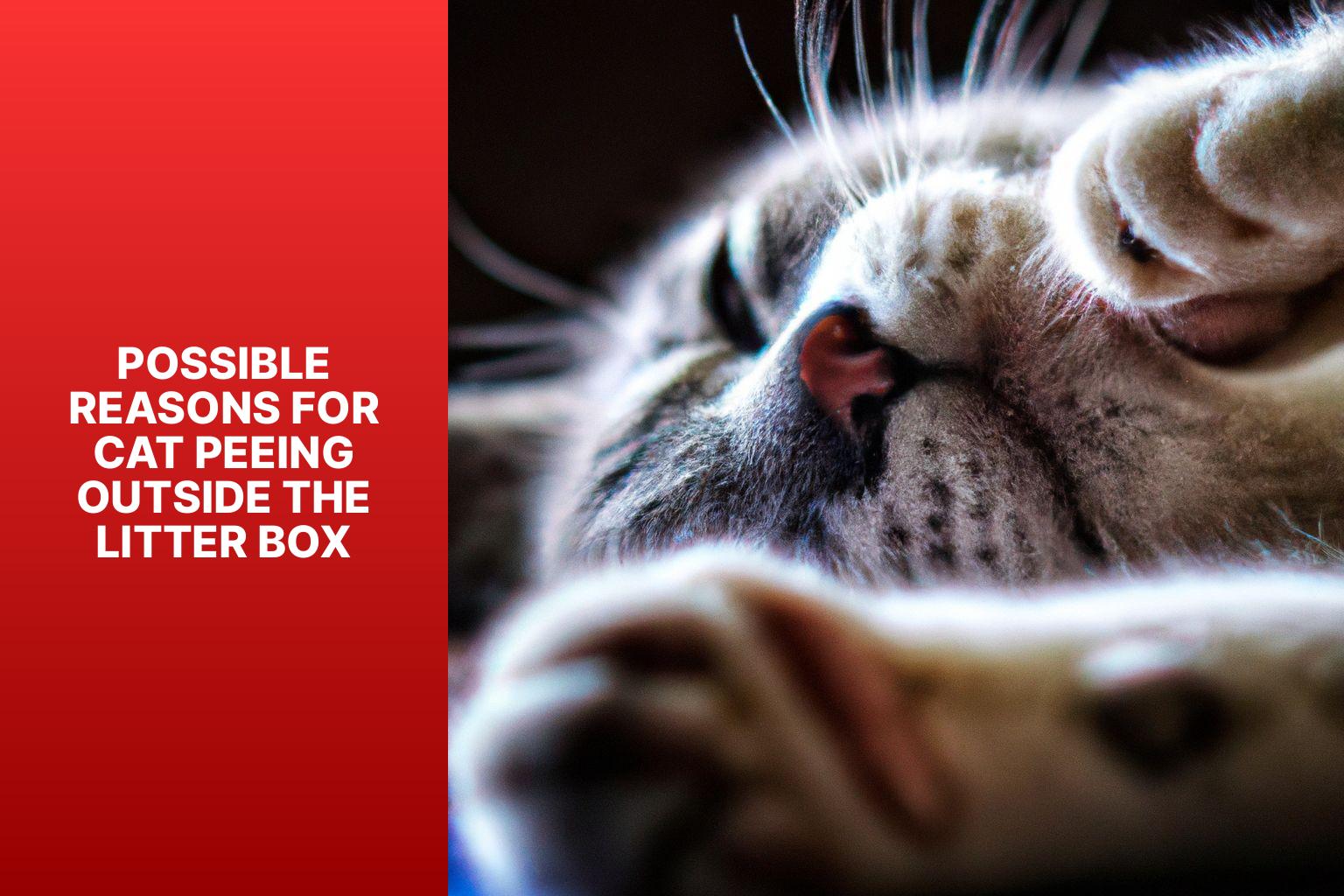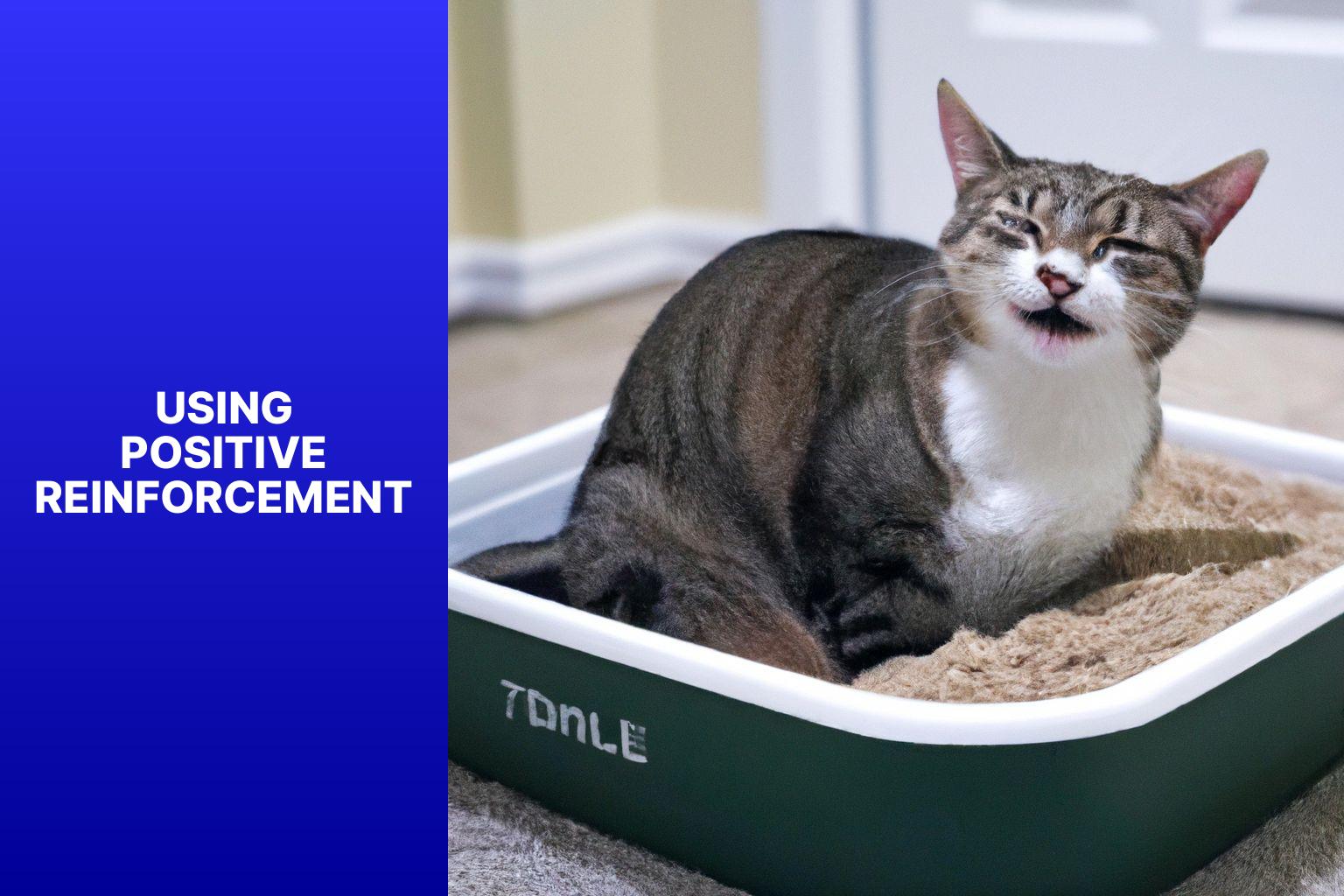Understanding the Behavior: Cat Peeing Outside the Litter Box
It can be frustrating and concerning when your cat starts peeing outside the litter box but continues to use it for pooping. This change in behavior may indicate an underlying issue that needs to be addressed. By exploring the possible reasons for this behavior, you can better understand your cat’s needs and take appropriate steps to resolve the issue.
Possible Reasons for Cat Peeing Outside the Litter Box:
- Medical Issues: Cats may urinate outside the litter box due to urinary tract infections, kidney problems, or other medical conditions that cause discomfort or increased frequency of urination.
- Litter Box Problems: Issues with the litter box, such as an unclean or inadequate box, wrong type of litter, or unpleasant location, can discourage cats from using it for urination.
- Stress or Anxiety: Cats are sensitive to changes in their environment and can respond by avoiding the litter box. Stress or anxiety can be caused by factors such as changes in routine, new pets, or household conflicts.
- Territorial Marking: Cats may urinate outside the litter box to mark their territory, especially if they feel threatened by other animals or perceive a need to establish dominance.
- Inappropriate Elimination: Some cats develop a preference for certain surfaces or textures and may choose to urinate elsewhere if they find the litter box uncomfortable or unsuitable.
Possible Reasons for Cat Pooping in the Litter Box:
- Litter Box Preference: Cats have individual preferences for the type of litter or litter box they prefer for bowel movements. If these preferences are not met, they may choose to defecate outside the litter box.
- Medical Issues: Just like with urination, medical problems such as gastrointestinal issues or pain while defecating can lead to cats avoiding the litter box.
- Behavioral Issues: Changes in routine, anxiety, or stress can also cause cats to poop outside the litter box. It can be a way for them to communicate their discomfort or dissatisfaction.
Understanding the Connection Between Peeing and Pooping Behaviors:
There is often a strong connection between a cat’s urination and defecation behaviors. Changes in one aspect can potentially influence the other. Therefore, it is essential to consider both urinary and bowel habits when addressing litter box issues.
How to Address the Issue of Cat Peeing Outside the Litter Box but Pooping in It:
- Veterinary Examination: Schedule a veterinary examination to rule out any underlying medical conditions.
- Ensuring Litter Box Hygiene: Keep the litter box clean and provide the right type of litter based on your cat’s preferences.
- Eliminating Stressors: Identify and address any sources of stress or anxiety in your cat’s environment.
- Providing Multiple Litter Boxes: Have multiple litter boxes in different locations, accessible and appealing to your cat.
- Using Positive Reinforcement: Praise and reward your cat when they use the litter box correctly to encourage the desired behavior.
By understanding the reasons behind your cat’s inappropriate elimination behavior and implementing the appropriate measures, you can help your feline companion return to using the litter box consistently and maintain proper hygiene.
Key takeaway:
- Understanding the Behavior: Cat Peeing Outside the Litter Box can have various reasons, including medical issues, litter box problems, stress or anxiety, territorial marking, or inappropriate elimination.
- Understanding the Connection Between Peeing and Pooping Behaviors is essential to address the issue effectively.
- To address the issue of cat peeing outside the litter box but pooping in it, veterinary examination, ensuring litter box hygiene, eliminating stressors, providing multiple litter boxes, and using positive reinforcement can be helpful strategies.
Understanding the Behavior: Cat Peeing Outside the Litter Box
Understanding why a cat pees outside the litter box can puzzle cat owners. To address this issue, consider the following factors.
First, rule out any medical conditions by visiting a veterinarian.
Second, understand that cats are creatures of habit and changes in their environment or routine can cause stress or anxiety. Create a calm and stable environment to help prevent litter box problems.
Third, consider the type of litter box and litter used. Cats have preferences, so provide one that suits their needs. Some cats may have sensitivities to certain types of litter, so try different options.
Lastly, maintain a clean litter box. Cats are clean animals and may avoid a dirty litter box. Scoop the litter box daily and completely change the litter regularly.
If the problem persists, try using a litter attractant or consult a professional animal behaviorist for guidance. Understanding your cat’s behavior and addressing the underlying causes can resolve the issue and keep your cat happy and healthy.
Possible Reasons for Cat Peeing Outside the Litter Box
Photo Credits: Www.Catcornerblog.Com by Jeremy Miller
Discover the potential reasons behind your cat’s unusual litter habits. Unravel the mystery of why your feline friend is peeing outside the litter box while still faithfully pooping in it. From medical concerns to litter box woes, stress and anxiety, territorial marking, and inappropriate elimination – we’ll explore the various factors that may be influencing your cat’s behavior in this eye-opening investigation. Get ready to gain insights into your purrfect companion’s mind!
1. Medical Issues
When your cat pees outside the litter box but poops in it, medical issues may be the cause. These issues include:
- Urinary Tract Infection: Cats with urinary tract infections may feel discomfort or pain while urinating, leading them to associate the litter box with this unpleasant sensation. As a result, they may choose to urinate outside the box.
- Bladder Stones: Bladder stones can cause similar discomfort and pain, leading to avoidance of the litter box for urination.
- Inflammatory Bowel Disease: This condition affects the digestive system, including the colon, causing changes in bowel movements. While the cat may still choose to poop in the litter box, the urge to urinate may trigger them to go elsewhere.
- Constipation: Cats with constipation may struggle to pass stools, associating pain or discomfort with the litter box. They may prefer to find alternative places to defecate.
- Other Medical Conditions: Various other medical issues can affect a cat’s urinary or digestive systems, leading to changes in bathroom behaviors. It is important to consult a veterinarian to identify and address any underlying health problems.
If your cat is exhibiting this behavior, it is important to first rule out any potential medical issues. A veterinary examination can help diagnose and treat any underlying conditions that may contribute to the problem.
2. Litter Box Problems
Common litter box problems, such as dirty litter boxes, the wrong type of litter, inconvenient litter box locations, small litter box sizes, and underlying stress or anxiety can cause your cat to pee outside the litter box. It is important to address these issues to ensure your cat’s proper litter box usage.
- Dirty litter box: One of the common reasons cats avoid using the litter box is its uncleanliness. To prevent this, make sure to clean the litter box regularly for hygiene purposes.
- Wrong type of litter: Cats have their own preferences when it comes to litter. It is advisable to experiment with different types of litter to find the one your cat prefers.
- Litter box location: Cats prefer private and quiet locations for their litter boxes. Avoid placing it in noisy or high-traffic areas to provide a suitable environment.
- Litter box size: Make sure the litter box is large enough for your cat to move and dig comfortably. An adequately sized litter box will promote proper usage.
- Stress or anxiety: Cats can experience stress or anxiety due to changes in their environment, which may lead to litter box aversion. Identify and eliminate any sources of stress to alleviate this issue.
To address these litter box problems effectively, consider the following suggestions:
- Keep the litter box clean by scooping it daily and changing the litter regularly. This will ensure a clean and appealing environment for your cat.
- Experiment with different types of litter to find your cat’s preference. This can help in promoting proper litter box usage.
- Place the litter box in a quiet and easily accessible location. This will provide the privacy and convenience that cats seek.
- Provide an adequately sized litter box to ensure your cat’s comfort. A spacious litter box will encourage your cat to use it regularly.
- Address any sources of stress or anxiety in your cat’s environment. This can be done by identifying the triggers and taking appropriate measures to eliminate them.
3. Stress or Anxiety
Stress or Anxiety
When cats experience stress or anxiety, they may exhibit inappropriate elimination behaviors, such as peeing outside the litter box. It is essential to consider various factors contributing to stress or anxiety in cats:
– Moved or new environment: Changes in the cat’s surroundings, such as moving to a new place or introducing new furniture, can trigger stress and anxiety, leading to elimination problems.
– Limited access to the litter box: If cats have restricted access to their litter box or if it is placed in a noisy area, this can cause them to feel stressed. To alleviate their anxiety, providing multiple litter boxes in different locations can be helpful.
– Conflict with other pets: If cats feel threatened by other pets in the household, it can result in stress and contribute to elimination issues.
– Changes in routine or household dynamics: Cats are creatures of habit, and disruptions in their routine or changes in the household can induce stress. This includes situations like welcoming a new baby, bringing in a new pet, or altering the cat’s primary caregiver.
– Past traumatic experiences: Cats with a history of abuse or neglect may be more susceptible to stress and anxiety, which can manifest as litter box problems.
A real-life example involving a cat named Max illustrates the significance of stress on litter box habits. Max had spent months in a shelter before being adopted. The transition to his new environment overwhelmed him, leading to inappropriate elimination. The family consulted with a veterinarian and implemented changes to minimize Max’s stress. These changes included providing him with a peaceful space, establishing a consistent feeding schedule, and using Feliway diffusers to create a calming atmosphere. With time and patience, Max’s litter box issues improved, underscoring the importance of addressing stress and anxiety to resolve inappropriate elimination behaviors.
4. Territorial Marking
When it comes to territorial marking in cats, consider these factors:
– Cats instinctually mark their territory through scent.
– They may mark objects to establish their territory.
– Unneutered or unspayed cats are more likely to engage in territorial marking due to hormonal influence.
– Cats may also mark territory in response to anxiety or stress.
To address territorial marking in cats:
– Have your cat spayed or neutered.
– Create a stable environment with minimal changes.
– Provide multiple litter boxes in different areas of the house.
– Clean marked areas thoroughly to discourage further marking.
Understanding the reasons behind territorial marking and taking appropriate steps can prevent this behavior and ensure a harmonious living environment for both you and your cat.
5. Inappropriate Elimination
Inappropriate elimination is a common issue that many cat owners face. It can be quite frustrating to deal with. There are several possible reasons for this behavior, including medical issues, litter box problems, stress or anxiety, territorial marking, and behavioral issues.
One of the main reasons why cats may urinate outside the litter box is due to medical issues. This could include urinary tract infections, bladder stones, or other conditions that cause discomfort or increase the urgency to urinate.
Litter box problems can also contribute to inappropriate elimination. Cats may avoid using a dirty litter box, one that has an unpleasant odor, or litter that they do not like.
Stress or anxiety can also trigger cats to urinate outside the litter box. This could be caused by changes in the environment, the introduction of new pets, or changes in their routine.
Territorial marking is another reason why cats may engage in inappropriate elimination. Unneutered male cats in particular may spray urine to mark their territory. This behavior can also occur in neutered males and female cats in certain situations.
In some cases, inappropriate elimination could be a result of behavioral issues. Some cats may engage in this behavior as a way to seek attention or as a response to conflicts with other cats in the household.
To illustrate the impact of appropriate measures, let me share a true story. I had a cat named Max who started urinating outside the litter box after we moved. Concerned about his health, we took him to the vet and ruled out any medical issues. We soon realized that the move had caused stress for Max. To alleviate this, we provided him with a quiet and safe space and added an extra litter box there. With patience and consistency, Max’s inappropriate elimination gradually stopped. It’s important to understand the underlying cause and make appropriate changes to resolve this issue effectively.
Possible Reasons for Cat Pooping in the Litter Box
Is your feline friend making a mess by pooping outside of the litter box? Let’s explore the possible reasons behind this behavior. We’ll dive into different factors that may contribute to this issue, such as their litter box preference, potential medical issues, and even behavioral factors. By shedding light on these sub-sections, we can uncover the root cause and find effective solutions to keep your cat’s business where it belongs – in the litter box!
1. Litter Box Preference
Litter Box Preference
– Cats have individual preferences for litter boxes. Some cats prefer specific types of litter, such as clumping or non-clumping, scented or unscented. It is important to consider your cat’s litter box preference.
– The size of the litter box is important. Cats may prefer a larger litter box that allows them enough space to move and dig. Pay attention to the size that your cat prefers for their litter box.
– The location of the litter box is also important. Cats may prefer a quiet and secluded area where they can have privacy. Take note of the location that your cat prefers for their litter box.
– Cats have preferences for clean litter boxes. Some cats won’t use a dirty litter box and may avoid it if it’s not cleaned regularly. Make sure to clean the litter box regularly to accommodate your cat’s preference.
– Observe your cat’s behavior and preferences regarding litter boxes. If your cat consistently avoids a particular litter box, it may be a sign they prefer something different. Pay attention to your cat’s litter box preference and provide alternatives if needed.
2. Medical Issues
Medical issues can cause cats to pee outside the litter box. It’s important to address potential health concerns to resolve this issue. Cats can have urinary tract infections, bladder stones, or kidney disease, leading to inappropriate urination. These conditions can cause discomfort, making the cat avoid the litter box and urinate elsewhere.
Diabetes or hyperthyroidism can also increase urine production, making it difficult for cats to control their bladder or needing to urinate more often. In these cases, the litter box may not provide enough space, and the cat may look for other places to eliminate.
If your cat consistently pees outside the litter box, consult a veterinarian for a thorough examination. The vet can rule out any underlying medical conditions and provide appropriate treatment if necessary. Stay proactive in seeking medical attention to ensure your cat’s overall well-being.
Remember to always provide a clean and accessible litter box, eliminate stressors, and use positive reinforcement to encourage consistent use of the litter box. By addressing medical issues and providing support, you can help your cat regain proper litter box habits and maintain optimal urinary health.
3. Behavioral Issues
Behavioral Issues
When cats experience behavioral issues, such as peeing outside the litter box but still pooping in it, there are several potential causes. These issues can include stress or anxiety, territorial marking, and inappropriate elimination.
One common cause of this behavior is stress or anxiety. Cats can become stressed or anxious due to changes in their environment, the presence of other animals, or separation anxiety. This can lead them to urinate in inappropriate places.
Another possibility is territorial marking. Cats have scent glands in their paws and may choose to urinate outside the litter box if they feel threatened or want to mark their territory.
Inappropriate elimination is also a factor to consider. Cats may prefer certain areas of the house to eliminate if they have had accidents or if the litter box is not consistently cleaned. They may still use the litter box for defecation due to familiarity.
To address these behavioral issues, it is important to take certain steps. First, provide a stress-free environment for your cat by minimizing changes and creating a designated safe space. Make sure the litter box is cleaned regularly and easily accessible for your cat. Positive reinforcement, such as treats or praise, can also be used to encourage proper litter box usage. If the problem persists, it is advisable to consult with a veterinarian or professional animal behaviorist for further assistance.
By addressing these behavioral issues, you can help your cat develop proper litter box habits and maintain a clean and hygienic home.
Understanding the Connection Between Peeing and Pooping Behaviors
Understanding the connection between peeing and pooping behaviors in cats is crucial for pet owners. It is important to know why cats choose to urinate outside the litter box instead of using it for bowel movements. Here are some essential points to keep in mind:
1. Health issues: Cats may urinate outside the litter box if they are suffering from urinary tract infections, bladder stones, or other medical conditions. Therefore, it is essential to monitor their urine output and consistency.
2. Litter box cleanliness: Cats prefer a litter box that is clean. If the litter box is dirty or has a strong odor, they may avoid using it for peeing and pooping. Therefore, it is important to clean the litter box regularly.
3. Territorial marking: Cats may mark their territory by urinating outside the litter box, especially when they are stressed or anxious. This behavior is more common in unneutered cats. To prevent this, providing a calm and secure environment can be beneficial.
4. Litter box location: The placement of the litter box can have an impact on a cat’s behavior. It should be easily accessible and located in a quiet area, away from loud noises or high foot traffic.
Pro-tip: If your cat consistently pees outside the litter box but poops in it, it is advisable to consult a veterinarian to rule out any underlying health issues. Providing multiple litter boxes in different areas of the house can also help promote proper elimination habits.
How to Address the Issue of Cat Peeing Outside the Litter Box but Pooping in It
Is your cat causing a mess by peeing outside the litter box, but still managing to poop in it? Don’t worry, we’ve got you covered! In this section, we’ll dive into some practical solutions to address this issue and restore harmony in your feline friend’s bathroom habits. From veterinary examinations to ensuring litter box hygiene, eliminating stressors, and providing multiple litter boxes, we’ll explore effective strategies to tackle this frustrating problem. No more cat-induced surprises around the house, let’s get to the bottom of this!
1. Veterinary Examination
During the veterinary examination, the veterinarian assesses the cat’s health and behavior to determine the cause of the issue. The examination involves a physical exam and diagnostic tests such as bloodwork or urinalysis to rule out medical conditions causing the cat to urinate outside the litter box but defecate in it.
The veterinarian also asks about changes in the cat’s environment or routine that could contribute to stress or anxiety. They inquire about recent changes in the litter box setup or cleaning routine.
Based on the exam findings, the veterinarian develops a treatment plan tailored to the cat’s specific needs. This may include medication for medical issues, behavioral modification techniques, or environmental changes.
It is important to follow the veterinarian’s recommendations and update them on any changes or improvements in the cat’s litter box habits. Regular follow-up visits may be necessary to monitor progress and make any necessary adjustments to the treatment plan.
By seeking a veterinary examination, cat owners ensure that underlying medical conditions are addressed and appropriate steps are taken to resolve the issue of the cat urinating outside the litter box but defecating in it.
2. Ensuring Litter Box Hygiene
To ensure litter box hygiene and prevent cats from peeing outside the litter box but pooping in it, follow these steps:
1. Clean the litter box daily. Remove feces and clumps of urine-soaked litter and dispose of them. This will maintain litter box freshness and appeal to your cat.
2. Change the litter regularly. Empty the litter box completely and replace the old litter with fresh litter at least once a week. This will prevent odor buildup and provide a clean environment for your cat.
3. Use unscented litter. Some cats are sensitive to strong scents, so it’s important to stick to unscented litter to ensure your cat feels comfortable using the litter box.
4. Provide enough litter boxes. Aim for one litter box per cat, plus an extra one. This will ensure that each cat has their own space and help prevent territorial disputes. Place the litter boxes in separate areas of your home to accommodate your cat’s preferences.
5. Keep the litter box in a quiet and accessible location. Cats prefer privacy when using the litter box, so it’s best to place it in a quiet area where your cat won’t be disturbed. Also, make sure your cat can easily access the litter box at all times.
By following these steps, you can ensure proper litter box hygiene, create a clean and inviting space for your cat, and reduce the likelihood of them peeing outside the litter box but still using it for their bowel movements.
3. Eliminating Stressors
To eliminate stressors that may cause your cat to pee outside the litter box but poop in it, consider the following:
1. Provide a quiet and calm environment for your cat. Loud noises or sudden changes can stress them out and lead to inappropriate elimination.
2. Ensure your cat has a designated area for rest and relaxation. Creating a comfortable space with a cozy bed or blankets can help reduce stress.
3. Keep the litter box in a quiet and accessible location. Cats prefer privacy, so place it in a secluded area away from high-traffic areas to help eliminate stress.
4. Provide an adequate number of litter boxes. The general rule is one litter box per cat plus one extra. Having multiple boxes reduces competition and anxiety.
5. Regularly clean the litter box. Remove waste daily and completely change the litter at least once a week to maintain cleanliness.
6. Use pheromone products or diffusers. Synthetic pheromones mimic natural feline pheromones and can help create a calming environment for your cat.
7. Create a predictable and routine schedule for feeding, playtime, and litter box cleaning. Cats thrive on routine, which can help reduce their stress levels.
8. Minimize conflicts with other pets. Ensure your cat has a safe space away from other animals to retreat to when they need some alone time.
By addressing and eliminating stressors in your cat’s environment, you can create a more relaxed and comfortable space, which may help reduce their urge to eliminate outside the litter box.
4. Providing Multiple Litter Boxes
When a cat pees outside the litter box but poops in it, providing multiple litter boxes can help. Cats have different preferences for urinating and defecating, so having multiple options meets their needs. Here are some benefits of providing multiple litter boxes:
1. Preventing territorial conflicts: Cats are territorial. Providing multiple litter boxes reduces conflicts between cats when they have to share one box. Each cat has their own space to eliminate, promoting harmony.
2. Ensuring accessibility: Placing litter boxes in different areas of the house ensures easy access for the cat at all times. This is especially important in multi-story or large homes. Multiple options prevent the cat from avoiding the litter box due to distance or obstacles.
3. Reducing stress: Cats may feel stressed or anxious if they have to wait or compete for a litter box. Multiple boxes eliminate this stress, allowing the cat to feel more relaxed during elimination.
4. Maintaining cleanliness: Cats prefer a clean litter box. Having multiple boxes makes it easier to keep them clean and hygienic. Each box can be regularly cleaned without inconveniencing the cat.
To ensure effective use of multiple litter boxes, place them in different areas of the house and keep them clean. Also, observe the cat’s preferences and behaviors to determine if any modifications are necessary to meet their individual needs.
Using Positive Reinforcement
Photo Credits: Www.Catcornerblog.Com by Patrick Clark
Discover the power of positive reinforcement when it comes to addressing your cat’s litter box issues. We’ll explore how various techniques can help correct this behavior. From a thorough veterinary examination to ensuring litter box hygiene, eliminating stressors, and providing multiple litter boxes, each sub-section offers valuable insights that will help you create a hassle-free and happy environment for your feline companion. No more messy surprises—let’s get started!
Some Facts About Why Cats Pee Outside the Litter Box but Poop in It:
- ✅ Cat peeing outside the litter box but pooping in it is a common problem reported by cat owners.
- ✅ Medical issues such as urinary tract infections or blockages can cause cats to pee outside the litter box but still poop in it.
- ✅ Behavioral causes, such as territorial behavior or dissatisfaction with the litter box, may also lead to this behavior in cats.
- ✅ Solutions for medical issues may include veterinary treatment, antibiotics, or addressing underlying conditions such as diabetes or urinary crystals.
- ✅ Behavioral solutions for cats peeing outside the litter box but pooping in it may involve spaying or neutering, providing separate spaces for territorial cats, or addressing any messages the cat may be trying to communicate.







